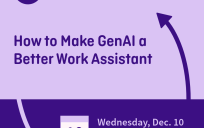Whether federal, state or local, agencies provide potentially life-changing services. But the older that processes and technologies get, the harder governments struggle to deliver vital benefits and services, such as driver’s licenses or health care.
Consider agencies with paper-based workflows. Internally, these agencies struggle with coordination; moving paper documents among teams can be cumbersome. Externally, paper-based communications slow outreach to stakeholders. In both scenarios, loose papers containing sensitive information create security risks. During crises such as natural disasters, these outdated business practices even harm the public by slowing response time to critical content.
“Fluidity is really important in today’s day and age,” said Chris Weatherup, Manager, Solutions Engineering at Box. “We need to make decisions faster. But speed and security are two hugely important vectors when we’re thinking about data.”
Another problem: Legacy processes and tools cannot support secure collaboration between on-premise and remote workers. As more people work remotely, agencies need devices and networks that are reliable across large distances without jeopardizing data.
Yet the problems do not stop there. Agencies need to comply with an increasingly wide range of federal, state, local and even global regulations. Consider FedRAMP. Agencies that do not meet FedRAMP standards can’t handle federal data, depriving them of a valuable resource.
Over-the-hill practices could hurt constituents the most. They expect private-sector businesses to serve them continuously and digitally and, increasingly, they expect the same in the public sector. They have few alternatives when agencies do not provide them with a similar CX.
“At the state, local and federal levels, they expect that type of citizen engagement,” Weatherup said of 24/7 online services for constituents. “It can be as simple as reporting a pothole to local government or as serious as reporting a whistleblower complaint to a federal agency. They want to get those issues into the hands of people who can help with them as soon as possible.”
Solution: Manage the Entire Content Journey in the Content Cloud
The solution? Moving content management to the cloud. Cloud-based content addresses key concerns around information-sharing, collaboration and security. It makes it possible for agencies to extend content to employees quickly and securely, whether they are working onsite or remotely.
It also improves internal and external collaboration for agencies. By storing all their data in the cloud, agencies make it instantly accessible to partners such as other agencies, regardless of location. Over time, this collaboration raises accuracy, transparency and information-sharing. Even better, the Content Cloud allows agencies to determine which internal and external partners can access assets such as data. This improves the control agencies have over some of their most valuable resources.
Lastly, the Content Cloud provides a place for agencies to report and analyze data. This system helps agencies make decisions by funneling information to the right people. Whether agencies’ data is structured or unstructured, the Content Cloud helps monitor, share and understand it better.
“People will always find the path of least resistance to collaborate and share information,” Weatherup said. “The Content Cloud gives people the best of all worlds: user experience, agility and security.”
This article is an excerpt from GovLoop’s recent report, “Modern Solutions for the Public’s Rising CX Demands.” Download the full report here.





Leave a Reply
You must be logged in to post a comment.